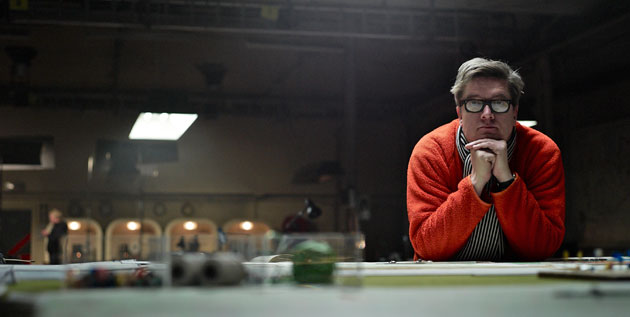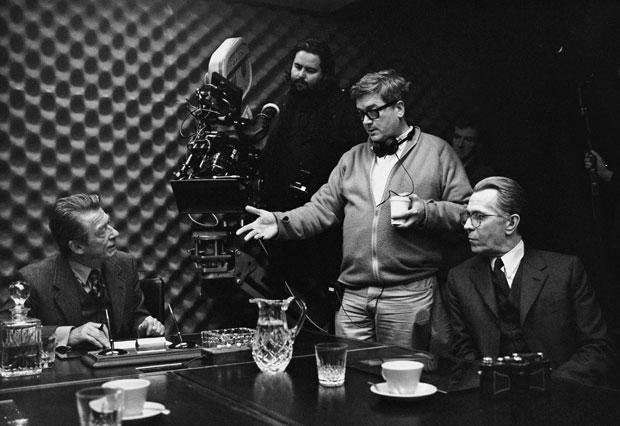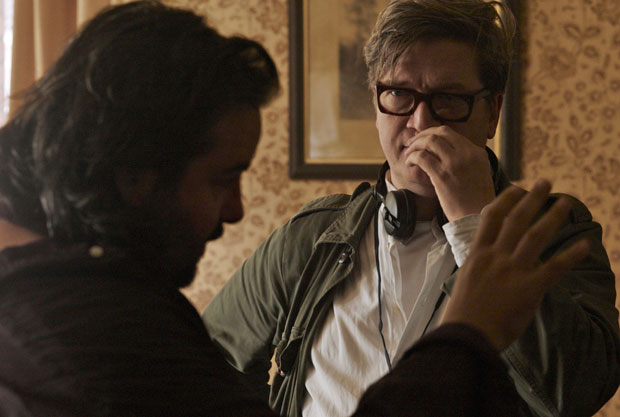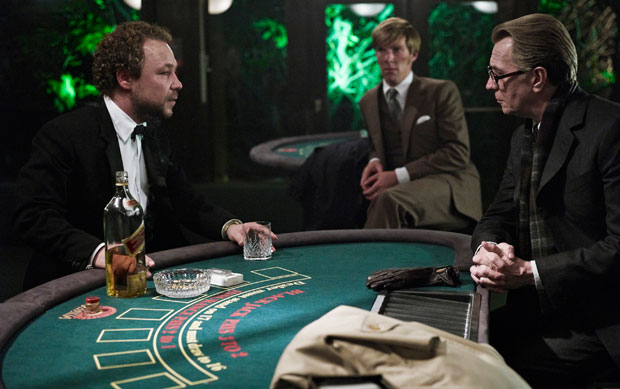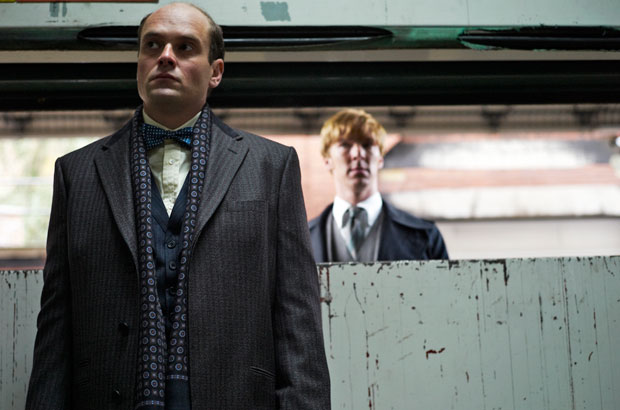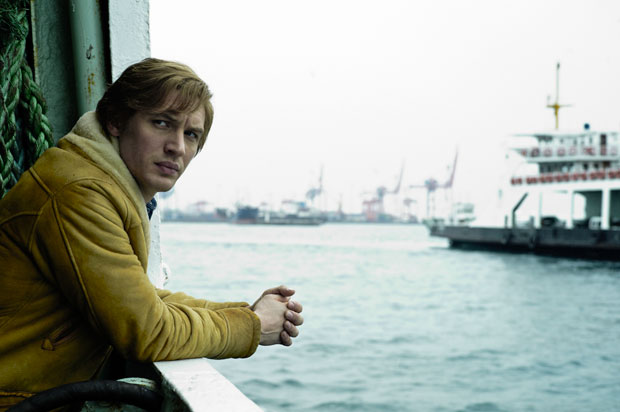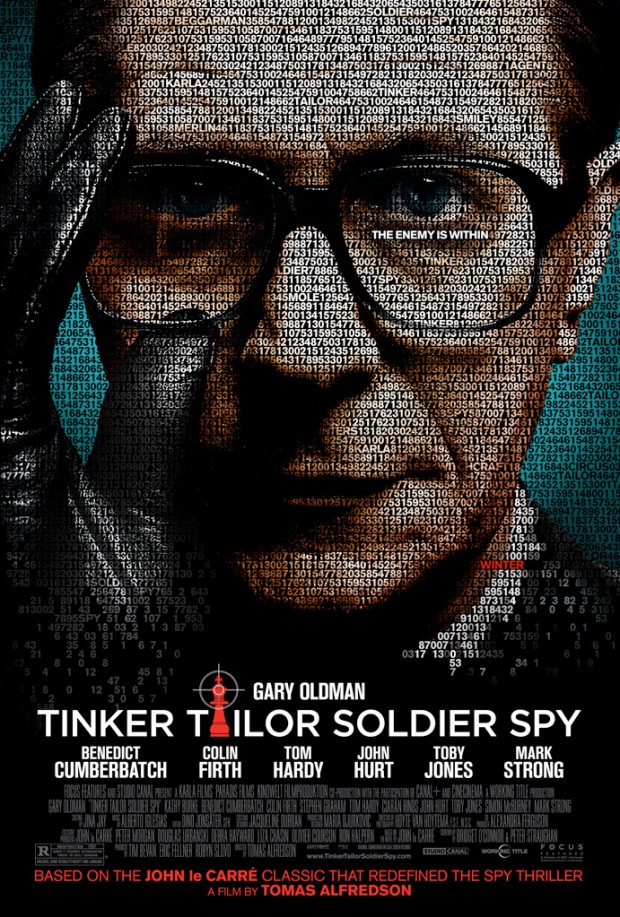While sitting down with director Tomas Alfredson and co-writer Peter Straughn, it became more and more obvious that these were the two smartest people in the room. To hear Straughn break down his approach (along with that of his co-writer, the late Bridget O’Connor) in adapting John le Carre’s absorbingly dense, intricately plotted 1974 classic was like listening to a textbook on the art of the best kind of film adaptation – the kind that translates a novel’s word-based aura into a visual, cinematic experience, rather than one that simply adapts a source text’s events at face value.
And what a perfect opportunity that provided Alfredson, who himself is a filmmaker deliberately focused on the senses. In the interview below, he talks about how he wanted to enliven Tinker with a scent — an approach that, to be sure, doesn’t sound wholly sane in the moment, but, upon reflection, manages to describe the film’s pinnacle effect in a creepily effective way. Those who recall Alfredson’s critically-acclaimed Let the Right One In will remember a film with an undeniable sense of atmosphere, and Tinker is no different. As Alfredson says himself, he is, above all, a ‘craftsman,’ and that dedication to detail reveals itself in every frame of his new film.
Best to let these two acute artists speak for themselves, though. You can read through the entirely of our chat below. And, in case you’ve been absent during the past two days, you can also catch up with our interviews with two of the film’s stars, Gary Oldman and Colin Firth.
How intimidating is it to tackle a feature-length version of a beloved, modern classic book by John le Carré that had been made into this landmark mini-series thirty years ago?
Peter Straughn (PS): Very. Very intimidating. We were persuaded to do it by two things. Firstly, that Tomas [Alfredson] lied and said he knew exactly how to do it. [Laughs.] And secondly, John le Carré wanted it to happen. He encouraged us to do it. There’d never been a film of it, and I think it’s probably the book closest to his heart, and he felt it could be a film.
What was the big jump that you had to make, then? Compression?
PS: Distillation, I think. Trying to hold true to the spirit and the tone of the book, and to fit in what is a quite complex plot, and yet leave the air, leave the melancholy tone and pace. You know, so it wasn’t just [people talking in rooms]. That felt like the [main] challenge.
Some of the contemporary spy pictures overwhelm with technology, yet this is such a refreshing change. Was that something that [drew you to it], too?
PS: Yeah. That’s it. At different times we had [technology] to play with — you have the big sting where he goes in to get the flowers, and [there’s] a telephone and a trolley. The height of technology. [Laughs.] I always enjoyed that about it.
Tomas Alfredson (TA): Yeah. But it’s also quite cinematic to depict how information travels [with] the old technology. If you were to open one of these [points to phone], you wouldn’t understand anything about it, but if you were to open up an old tape recorder, you might figure out what’s wrong with it or how to construct it. That reads very well on screen.
PS: And, also, the lack of technology means that there’s a lot more face-to-face drama. People have to talk to each other one way or the other, communicate with each other.
How did the casting process work? Did you start with Gary Oldman, and then move down the list?
TA: Yes. We had to have [George Smiley, the main character] in place first. And we were almost panicking because we couldn’t get the right idea to place George. The problem with George is that he is described as someone you would immediately forget. You know, anyone’s uncle. And to find an actor who could not be boring, but depict boredom or dullness – that was the trick. If you look at what Gary [Oldman] has done through the years, he’s very much a chameleon. And he was the perfect chameleon for us. So I went to Los Angeles with a very short list with one name on it, and we met and connected very well. And then we started the rest of the casting process. But [the rest] was quite easy. It just fell very naturally in place. I think [about 95%] of the cast were [our first choices].
What did you enjoy most about recreating the period of time depicted in the film?
TA: It’s quite fun as a filmmaker to recreate another era. Imagine doing a period piece about 2006 — what did they wear in 2006? It’s almost impossible to remember. But ’73 is much easier. So the distance makes it easier, the farther the distance. And especially if you have lived it yourself. I was eight years old then, so I remember quite clear what was happening. It’s a lot of fun — oh, this magazine I remember, and oh, this song I remember. I visited England the first time in 1973, and I’ve used a lot of those memories [in this movie].
Did you look at the miniseries at all? And did that have an impact the film’s look?
PS: I don’t think Tomas did. I don’t think the art department did. Bridget [O’Connor, the second screenwriter] and I watched it once before we started writing just to kind of get it out of the way. But that wasn’t for the look of [the film]. It was more just to — because we were under the shadow of it. It’s such a holy grail in the U.K., so we wanted to [prepare] by at least watching it once.
Can you talk about your visual approach to the movie?
TA: We tried to, me and Hoyte van Hoytema, the D.P., create a sense of paranoia. The scenes [were designed] to have the feeling as if there were a stranger in the room. So we tried to find the voyeuristic perspective. And, as you might notice, a lot of it is shot from outside – through a window or peeping holes. That was one idea we had. We also discussed [the possibility] of translating a scent into visuals. Try to imagine damp tweed, the scent of damp tweed, or, you know, cabbage or something. How would that look if you made a film that had that scent?
Did it help to do a very classic English story as an outsider, as [a foreigner]?
TA: I suppose, yes. I think the main difference [between] being a Swede and being English is that they have this very sophisticated class system that is very connected to the language, how people talk. [It] is very hard to understand how it works, and interesting to explore, I think – I’m not sure – but I think I see that clearer than you might.
How did you find the right balance between entertaining the audience and provoking them intellectually? And how important is it to trust the audience’s intelligence?
TA: Very much. I think too many films today are monologues, and you’re spoon-fed just exactly what the filmmakers want you to see and think. I think it’s much more interesting to have a dialogue and to trust the audience’s intelligence. And that you suggest stuff. That you have to work a little as a viewer – why not? I don’t want to decide everything in a film. Like, the ending; I have heard so many interpretations [of] what happens there, what kind of action that is. And that’s wonderful to hear that it could be interpreted so differently. I think the audience is a very useful part of the whole cinema experience. [You should be] a little exhausted afterwards. It’s nice. In this kind of a film, you shouldn’t be sure, and you should do some work.
Are there plans to shoot the other Karla trilogy books?
TA: There are ideas and plans and intentions.
PS: Yeah we talked about it. The obvious choice would be [the third book in the trilogy] Smiley’s People. The second book in this trilogy is The Honourable Schoolboy, but it’s set entirely in Hong Kong and George Smiley is not a major character in it. But we might possibly take some material from that and create a compilation [sequel] when the time is right, maybe.
Do you see this as a modern horror story? Since you’re famous for your vampire movie [Let the Right One In], did you see this as linked to that in some way?
TA: You know, I don’t consider myself much of an artist. I’m a craftsman. I’m just doing stuff. I don’t see from outside what I’m doing. I just dig in.
Tinker, Tailor, Soldier, Spy is now in limited release.

